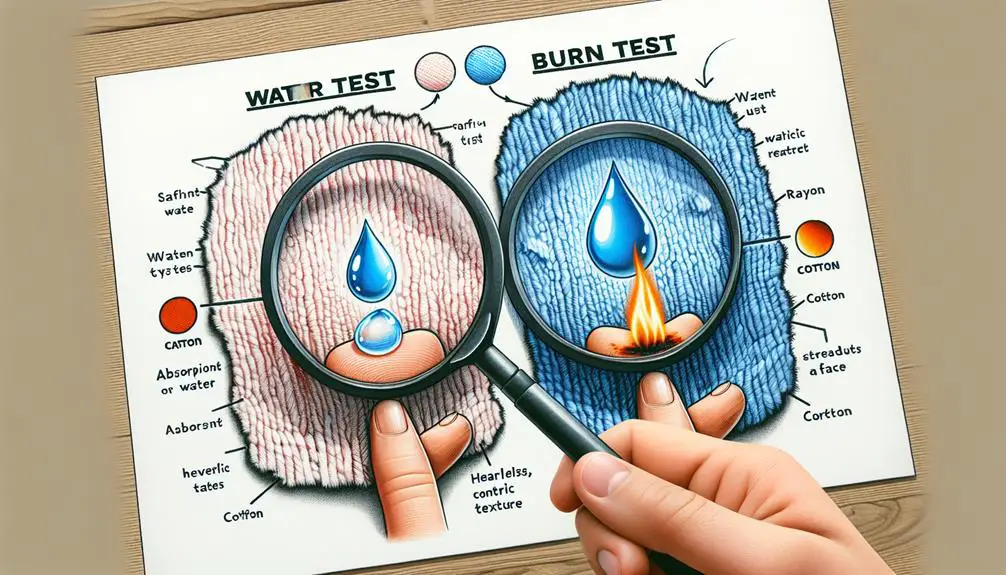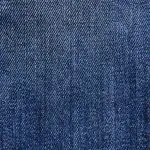I've been experimenting with different fabrics for my projects, and I've gotta say, figuring out if a fabric is rayon has been quite the puzzle. Sure, the label's a good starting point, but what if it's missing or you've got a vintage piece on your hands? Rayon's got that smooth, luxurious vibe, kind of like cotton's cooler cousin, but it's the burn test that really gets interesting. Snip a tiny piece, light it up, and it's game on to see if it smells like burning paper. But here's the kicker, there's more to the story than just a simple flame test. Let's just say, the results might surprise you.
Table of Contents
Key Takeaways
- Check the label for 'rayon' or 'viscose' to verify the fabric's composition.
- Feel the texture; rayon is smooth, soft, and has an elegant drape.
- Conduct a burn test; rayon burns quickly, smells like burning paper, and leaves soft ash.
- Perform a water absorption test; rayon fabric will quickly absorb water due to its cellulose base.
- Use chemical tests, such as bleach or acetone, which weaken or dissolve rayon, for confirmation.
Checking the Label
First off, always peek at the label to see if it says 'rayon' or 'viscose.' That's your first clue you're dealing with rayon fabric. The label's like the secret decoder ring for fabric; it spills the beans on what you're actually holding. If you see a mention of a cotton blend or even polyester mixed in, don't sweat it. Rayon loves company and often hangs out with other fibers to amp up its game, especially in terms of durability and feel.
Now, if the label's playing hard to get, or maybe it's just MIA, there's another trick up my sleeve – the burn test. Sounds a bit out there, but hear me out. A tiny, controlled burn can tell you loads about the fabric. Rayon has its own signature way of burning, but let's not dive into pyro territory without proper guidance or necessity. Always check the label first, and only play detective with the burn test as a last resort.
Texture and Drape
Diving into rayon's texture and drape, you'll notice it's got this smooth vibe that's pretty much like the real deal when you compare it to natural fibers like cotton. The thing about rayon fabrics is they're not just trying to be good as cotton, they're nailing it. They've got this soft and comfortable touch that really makes you wonder if you're touching a luxury version of cotton fabric.
Now, let's talk drape. Rayon's got this fluid, almost luxurious way of falling that makes any garment look elegant and graceful. You know those dresses that just flow perfectly and make you look effortlessly chic? That's rayon working its magic. It's not stiff; it moves with you, creating this gentle flow and movement that seriously flatters the body. And when it comes to design, rayon is a dream. It allows for beautiful gathers, pleats, and folds, which is why it's a go-to for those flowing and draped styles.
The Burn Test
To figure out if you've got rayon on your hands, the burn test is a straightforward trick you can try. First up, you'll need to snip a small piece off your fabric. Don't worry; it doesn't have to be big. Then, find yourself a safe spot and light it up. Now, here's where you've got to be sharp. If it's rayon, that fabric burns pretty quickly, more like whoosh, and then it's on its way to becoming ash.
You'll notice the smell too. It's going to hit your nose something fierce, but not in a bad way. It's like burning paper or leaves. That's your giveaway. Unlike those weird plastic-y smells you get from synthetics, rayon keeps it natural because of its cellulose composition.
And after the flame's done its thing, take a gander at what's left. Rayon leaves behind this soft ash residue that crumbles when you poke it. It's not sticky or hard like what you'd get from melting plastics. So, if you see that and you've smelled that paper-like scent, congrats, you're likely dealing with rayon. No fancy equipment needed, just your senses and a bit of fire safety.
Chemical Tests
Beyond the burn test, you can also try a couple of chemical tests to spot rayon fabric. After seeing how rayon burns, leaving ash and a chemical smell, let's dive into the bleach and solvent tests. These can really clinch the deal if you're still not sure.
| Test | What to Do |
|---|---|
| Bleach Test | Drop a bit of bleach on a small fabric area. Rayon weakens and falls apart. |
| Solvent Test | Dip a corner in acetone. If it dissolves, bingo—it's likely rayon. |
The bleach test is pretty straightforward. If you see the fabric disintegrating after applying bleach, it's a strong hint you've got rayon on your hands. Just remember, it's a bit destructive, so pick an inconspicuous spot.
The solvent test, using acetone, is like a magic trick. Not all fabrics will vanish in acetone, but rayon? It dissolves. This test is less common but super telling.
If you're still scratching your head after these, maybe it's time to hit up a pro. But honestly, with these tests in your toolkit, you'll likely have your answer on whether that mystery fabric is rayon or not.
Water Absorption Test
After checking out the bleach and solvent tests, let's give the water absorption test a shot to spot rayon. This one's a breeze and super telling. You just dunk a small piece of the fabric in water and watch it do its thing. Rayon, being the thirsty, cellulose-based fabric it is, sucks up water like nobody's business. It's like that friend who can't resist a good gossip—quick and all in.
So, here's the deal: if your fabric dives into the water and gets heavy with it, chances are you're holding rayon. It's because of its natural fiber vibes, being all cellulose-based. This test is a solid clue because rayon's water-loving nature sets it apart from other fabrics. Cotton and rayon might both be fans of a good soak due to their natural fiber status, but rayon takes it to the next level with how fast and deeply it absorbs water.
Make sure you really let it soak through. We're talking thoroughly drenched. This isn't a quick dip; it's a full-on baptism. That way, you get a clear picture of how rayon is in a league of its own when it comes to getting wet.
Professional Assessment
If you're still on the fence about whether your fabric is rayon, a pro's once-over can clear up any doubts. You see, reaching out to a fabric expert or a textile laboratory gets you more than just an opinion. These folks dive deep into the nitty-gritty of your fabric, using a bunch of high-tech tests to figure out exactly what it's made of.
They kick things off with fiber analysis, which is basically detective work at a microscopic level. Then, they might move on to chemical tests, which sound a bit intimidating but are super effective at identifying materials. By breaking down the fabric's composition, structure, and properties, they can confidently tell you, 'Yep, that's rayon' or 'Nah, you've got something else here.'
What's cool is that these professionals provide accurate and reliable results. No guesswork, just facts. So, consulting with a textile expert doesn't just give you peace of mind; it ensures you've got the precise identification of your fabric. Trust me, when it comes to figuring out if you're dealing with rayon, these pros are worth their weight in gold.
Frequently Asked Questions
How Can You Tell if Fabric Is Rayon?
I check for a silky texture and sheen, which rayon's known for. I'll also see how it drapes. Then, there's the burn test; it smells like burning paper. Lastly, I read the care label.
How Do You Detect Rayon?
To detect rayon, I'd check the label first for "viscose" or "rayon," then feel for a smooth, silky texture. I'd also do a burn test; it burns quickly, smelling slightly like burnt paper.
How Can You Tell the Difference Between Cotton and Rayon?
I can tell cotton from rayon by feeling their texture—cotton's slightly rough, while rayon's smoother. Rayon's vivid colors and easy wrinkling also give it away, along with its softer touch and better drapability.
What Does Rayon Material Look Like?
I'd describe rayon material as smooth, slightly shiny, and really soft. It hangs beautifully, kinda like silk, and feels light and comfy. It's got that luxurious vibe, but without the hefty price tag.
- Tetron Fabric for Marine Applications: Durability and Use Cases - June 18, 2025
- Tetron Fabric for Outdoor Furniture: Weather Resistance and Care - June 18, 2025
- Tetron Fabric for Wall Coverings: Style and Application Tips - June 18, 2025







